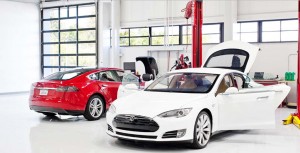
Tesla's early success gives proponents of the Energy Dept. loan program something positive to point to.
Senior officials from the Department of Energy have signaled the Obama Administration is ready to restart a controversial automotive loan program designed to kick-start the development of alternative vehicles.
The program was effectively put on hold two years ago following several problems and halt in funding was blamed for the failure of several potentially promising recipients – while critics blamed poor oversight for the loss of money loaned to several other start-ups.
A total of $15 billion, or 60% of the original $25 billion set aside for the Advanced Technology Vehicle Manufacturing program is still set aside and there is no official end date the administration has to meet. But proponents point to the need to rush new technologies to market to meet upcoming increases in fuel economy standards – and they point to California start-up Tesla Motors as a successful example of what the ATVM program was meant to achieve.
“We are actively looking at what might be an effective new (request for funding),” new U.S. Energy Secretary Ernest Moniz told The Detroit News. He recently took over the department from Steven Chu who put the program on hold during the second half of the Obama Administration’s first term.
(Tesla repaying government loan nine years ahead of schedule. Click Here for more.)
The ATVM project came under intense criticism from Republicans, notably including 2012 presidential nominee Mitt Romney who referred to the companies that had been funded as “losers.”
Indeed, there have been a few, including Vehicle Production Group which defaulted on a $50 million loan in June, and Fisker Automotive, the California-based plug-in hybrid maker that is not expected to pay back most of the $193 million it received from the loan program.
The Energy Dept. originally approved $529 million for Fisker before pulling the remaining loan when the automaker missed critical targets. And that triggered a decision to put other loans on hold, including one for another California venture, Next Auto, which wound up closing down when it couldn’t get funding. Several other promising projects also faltered without access to the low-interest government loans. And major automakers, including Chrysler and General Motors, eventually withdrew their own applications.
There have been a number of successes, as well, and proponents of the ATVM program point out that even the best venture capital firms routinely succeed with only a handful of the projects they back.
Among the highlights of the advanced vehicle program, Tesla Motors recently used proceeds from a new stock offering to pay off its $465 million start-up loan nine years ahead of schedule. Tesla is now valued by investors at roughly $20 billion, or more than Fiat/Chrysler and PSA Peugeot Citroen combined.
(Chrysler withdraws ATVM loan request. Click Here.)
Other successful loans have included $5.9 billion to Ford Motor Co., which has launched an array of battery-based vehicles. Nissan Motor Co., which markets the Leaf battery-car, also received $1.4 billion in loans.
The Energy Department initially received around 100 applications. But all remaining bids for funding have either been rejected or withdrawn. It remains to be seen how long it will take to fire the program back up – and who will be the next to apply.

I don’t know if weighting the market in favor of EVs and hybrids will prove to be a good idea or not, but if that’s what’s wanted then the way to do it is not on the supply-side. All sorts of subvented transactions are possible to narrow the price/payment premium for EV over conventional. Make them cheaper and the buyers will come, I say, though we may live to regret it.
Obama and the EPA are trying to force EVs on consumers who are rejecting them over and over despite this administration already having wasted hundreds of millions in gifts to companies who have gone bankrupt because consumers do not want EVs as they are impractical for 99.9% of consumers.
Obama and the EPA specifically changed U.S. Diesel emissions requirements to stifle the sales of clean Diesels so consumers would consider EVs. Obama and the EPA implemented a 54.5 mpg CAFE standard to force car makers to produce and market EVs and hybrids to reduce the massive fines they are going to need to pay because they can’t meet the impossible 54.5 mpg CAFE number pulled out of the arse of a bureaucrat.
It’s all a disgrace and it will cost consumers an arm and a leg to the tune of $5K-$10K per car on conventional models while EV buyers get all sorts of tax breaks and subsidies.
Jorge, the reality is that EVs actually ARE practical for perhaps 1/2 or more of American motorists. Data show something like a third to a half of vehicle owners NEVER clock more than 100 miles in a day. And the vast, vast majority seldom even clock more than 50. Add the statistic that most households have two or more vehicles AND that at least one of those drivers will be more than comfortably able to get by on a given day with an EV’s range.
Okay, that said, you can also point out that the vast majority of Americans buy based on desires and expectations v practical needs. And that said, most want any vehicle in the household fleet to handle the trip to the family reunion, or to be able to keep moving unfettered in an emergency no matter what.
So, based on realities, EVs work, and plug-ins are even more so. Based on the way Americans shop for cars, well, that’s another story.
Paul A. Eisenstein
Publisher, TheDetroitBureau.com
SOS, DD.
Let’s see how many billions more of tax payer money Obama can throw away…